Elements of Indigenous Convocation
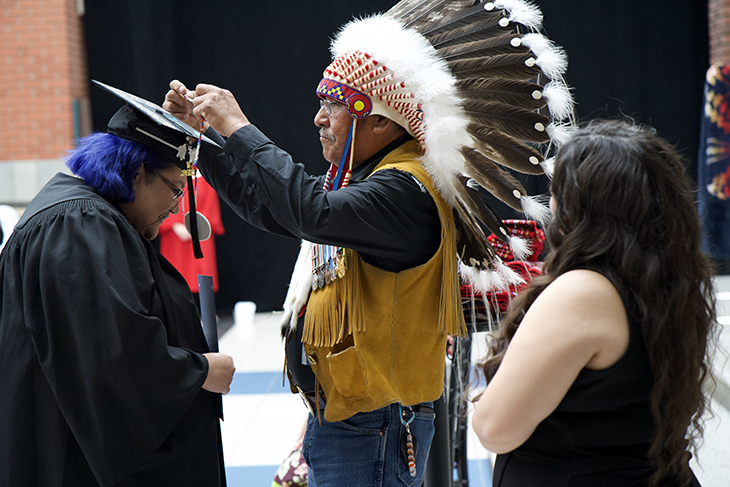
It’s convocation season here at SAIT. As we continue on our path of truth and reconciliation, one of the steps we’ve taken is holding a ceremony steeped in Indigenous cultures and traditions to honour our First Nations, Métis and Inuit graduates. This is an opportunity for our Indigenous community to come together in celebration of their successes with friends and family.
The grand entry
A tradition in Indigenous celebrations, the grand entry procession is led by Indigenous drummers with graduates and volunteers carrying flags from the Treaty 7 nations, Métis nation, Nunavut, Canada, Alberta and SAIT, as well as the Survivors’ Flag.
The role of flag bearer is held in high regard by graduates as the future leaders of their communities. They take immense pride in representing their nations and making their presence known as they carry the flags during a grand entry song to bless the space as sacred and ceremonial.
A Treaty 7 Elder, Métis Elder and Inuk Elder will offer opening remarks to share knowledge and words of encouragement as graduates prepare for a new journey ahead, and to highlight the impact of education on Indigenous communities. It’s important for children in attendance to see members of their family and community celebrating these successes ― to be able to look at them as role models and to see their own potential.
The meal hour
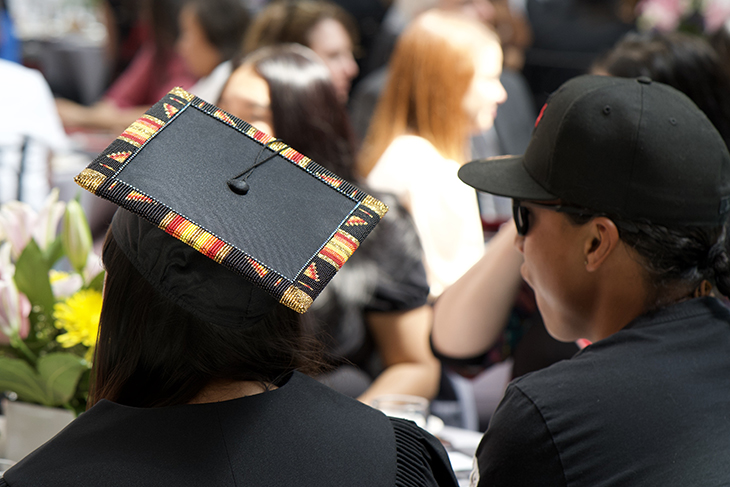
Before a feast commences, a blessing is offered to the families who travelled to join the celebration to thank them for their journey, as some families travel far distances. Feasting is an important ceremonial piece of Indigenous culture — to gather and be able to break bread and enjoy a meal together to celebrate community and success.
During the meal hour, performances will take place by First Nations dancers and Métis jiggers. The First Nations dancers exhibit different styles of powwow dance and Métis jigging is best described as a combination of First Nations, Scottish and French-Canadian step dancing.
Traditional gifting
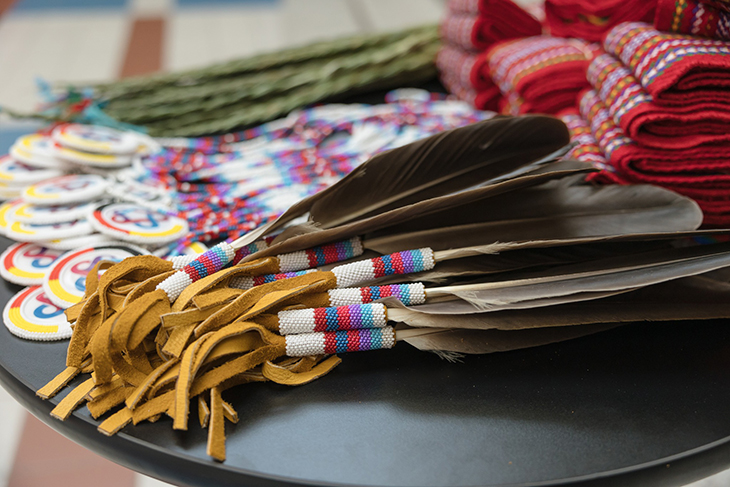
Following the meal hour, graduates will receive traditional gifts, which are culturally symbolic of an extremely high honour bestowed during significant life milestones. Our Métis students receive a sash and First Nations students receive an eagle feather.
We have an Inuk graduate this term who will receive an ulu — a traditional female-centric knife with a crescent shaped blade. The ulu is a multi-purpose tool passed down through generations or gifted to Inuit women during rights of passage.
The Métis sash
Originally used by French voyageurs, the brightly coloured, woven sash was adopted and changed by their Métis sons. The sash was used both as a decorative piece of clothing and as a multi-use tool — doubling as a rope, towel, saddle blanket or sewing kit as needed. Today, the sash symbolizes pride and nationhood for Métis people, and it is an honour bestowed upon members of the community who have made cultural, political or social contributions to their people.
Eagle feather
The eagle is a symbol of truth, power and freedom as it roams the sky. Its wings represent the balance between male, female and two-spirit people, each dependent on the strengths and abilities of the other. When holding the eagle feather, one must speak the truth as positively as one can, for the ear of the Creator is close to the feather of the eagle. Indigenous people honour the eagle feather with great care, showing it respect and honesty at all times. To be given an eagle feather is the highest honour that can be awarded within First Nations culture.
Blanket ceremony
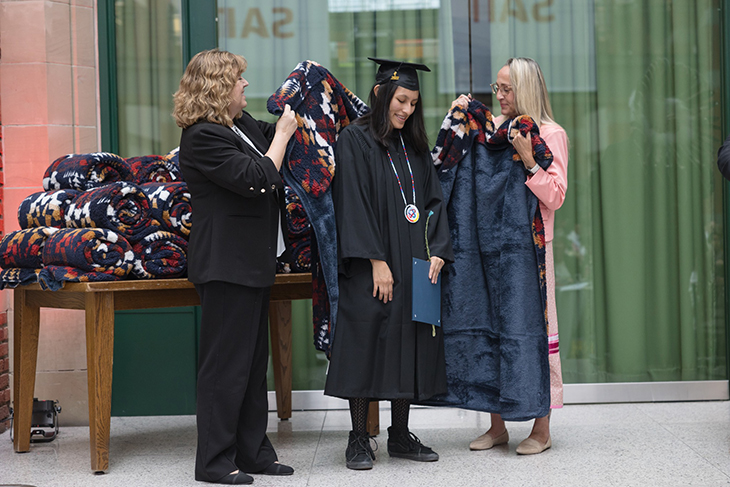
Blankets symbolize warmth and protection. They were one of the most commonly traded items amongst Indigenous ancestors and are still received as honourable gifts for Elders, knowledge keepers, and in recognition of a milestone event.
During the convocation ceremony, the blanket will be opened by two leaders in the SAIT community to bring together the physical and spiritual worlds. The graduate will stand proudly amongst their peers, family and community members as the blanket is ceremonially lifted up to the shoulders four times — for the east, south, west and north — symbolizing prayers for physical, mental, emotional and spiritual well-being. The blanket is wrapped around the graduate and will be their strength and protection as they begin their new journey.
Honour song and round dance
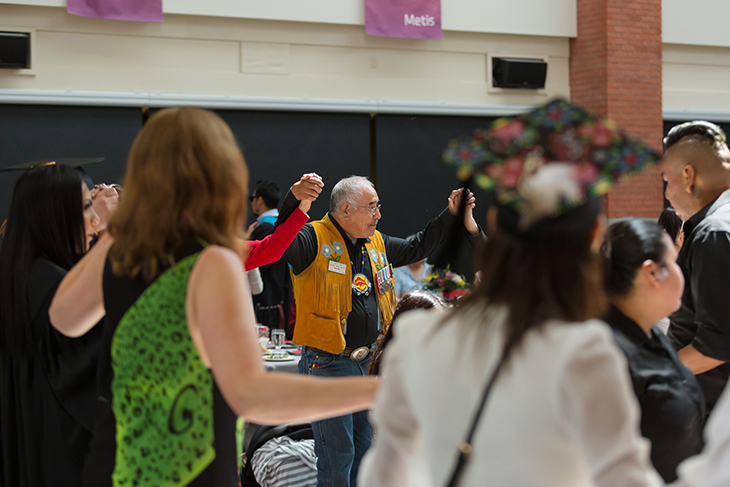
The ceremony will conclude with an honour song and round dance. An honour song is a right of passage to recognize Indigenous graduates as leaders of their communities — to honour the work they’ve completed and their journeys ahead. For the round dance, attendees will hold hands to gather in a circle and move by step-stepping to the sound of drums, symbolizing the beating of the heart.
Elder Rod Scout with the Blackfoot Confederacy
Honorary Bachelor of Business Administration
In recognition of his lifelong commitment to the community and preservation of Blackfoot culture, language and identity, SAIT has awarded Elder Rod Scout with an Honorary Bachelor of Business Administration.

Oki, Âba wathtech, Danit'ada, Tawnshi, Hello.
SAIT is located on the traditional territories of the Niitsitapi (Blackfoot) and the people of Treaty 7 which includes the Siksika, the Piikani, the Kainai, the Tsuut’ina and the Îyârhe Nakoda of Bearspaw, Chiniki and Goodstoney.
We are situated in an area the Blackfoot tribes traditionally called Moh’kinsstis, where the Bow River meets the Elbow River. We now call it the city of Calgary, which is also home to the Métis Nation of Alberta.